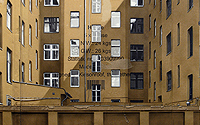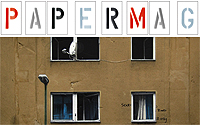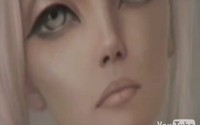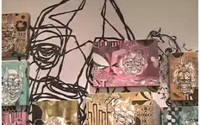The Street Art of Evol: A Social Dystopia
German street artist, Evol, explains how the architecture of a job center and ex-Stasi HQ in Berlin inspired him to turn power boxes into tenements.
By James Buxton

Power boxes can be found on almost any street, in any city around the world, yet in the hands of German artist, Evol, these unassuming objects are transformed into tower blocks and council flats. They become monuments to a social utopia that turned sour, they become metaphors for the state of the city itself.
Since early 2000, the Berlin-based artist, has been painting his miniature trompe l’oeil tenements on the streets, carrying out subtle interventions in public space and conceptually altering the way we experience the city. His work has received much critical acclaim but not much has been written about the elusive artists ideas. Here, we discuss how he stumbled across his ingenious idea as he was trying to “finance his next cigarette.”

How did you start working on the streets?
Evol: That’s connected to the question where my stupid name comes from. Actually, I started with spray cans rather late, when most people start at 14 or 15, I started at 19 maybe. I was raised in a smaller city, I wasn’t interested in graffiti. And then a friend asked me to paint a record store. It was a paid job. It probably looked terrible because we were imitating what we thought was graffiti. At this point I was only drawing black and white. I was too lazy to mix paint so I thought spray cans are the perfect medium. I found that I could paint wherever I want outside and people have to see it whether they want to or not!
I was rather fast in learning techniques and someone told me, “Dude, no one can do this stuff you are doing!” I was doing regular graffiti, I was the character guy between the style guy, and then I started painting trains, but I got bored of this hierarchy in graffiti very quickly.

I’ve interviewed a lot of artists creating interventions in public space and many of them have told me that they started with the characters but then got bored.
I remember when I did my first train, it was an end to end panel, we were three, I was on the very left, it was rather exciting, so I would choose a name and this was in ’95 or ’94 and I painted it in a very floral, abstract way, in the scene they were like “Nice train, but what the hell is this style man?”
So. you were kind of taking the piss out of the whole thing?
I just didn’t care, I was excited by the idea of doing something visual outside. I liked meeting these people even though they had very narrow interests, all these style questions were very boring for me, but I met a lot of very good people.

So I stopped doing this when I started to study product design, where I had access to a lot of different techniques like screen printing. Once I was in Berlin, I started drawing characters. Characters were my thing, so for a time we were doing a project called F*ck Your Crew, annoying graffiti guys here with hand drawn posters.
In contrast to graffiti, where you draw your own name everywhere and you develop your own way of doing it, I was not interested in putting my name there almost like an advertisement, like a brand’s name, I was more getting to the point where the space itself was more important to me. I was looking for a good location and how to change it in a more subtle way. I didn’t like this going over and screaming my name or something.

How did that develop?
These characters for instance, that was 2003 in Berlin and so it was the start of all the street art rush. There was so many people in my neighborhood and we all shared this kind of stuff and walking around was one of the biggest pleasures you can have, we were walking the streets seeing what someone else was doing, we were finding new spots and then making something for this spot.

The space was inspiring the work in a way?
When I was doing this character stuff, that was more elaborate, but comparable to go tagging, I had a simple figure, which was a fly, with three long legs, I just needed one black can and to walk, I was just walking and finding architectural situations whatever the location offered me. This was my first taste, and how I got hooked.
I’d rather not dominate something but give it a twist, within this I stumbled over these electrical boxes, which are on every street corner in Berlin, with posters for some concert and I thought, no one is doing something, so what to do with these, that’s like a format, it’s not only in every street and in every city but in every country. So I came with this idea of turning them into small apartments, which is a bit of a political or social critique which this came from.

I’ve been to Berlin a few times and felt the oppressive atmosphere of these big socialist blocks. How does history influence your work?
One of the reasons I started making these was not only because I was looking for an idea to do something with these power boxes. At that time I was so broke that I didn’t know how to finance my next cigarette. At the end I had to go to a government job agency and the closest one to where I lived was in Lichtenberg and once you go there you are depressed anyway because you are rather helpless because you are looking for a job rather desperately, and I went there and it was located in one of these buildings and I thought, “Jesus, people are down on their knees already and they just smack you up in the face with the architecture on top of it.” That was the second reason why I started doing this.

This kind of architecture, if you see it in a historical context, after the second World War there was a huge lack of living space in the GDR and this was somehow the only solution which was generating enough living space, which was cheap. But they made a whole idea around it, this social dream, where everyone is equal, not a class society system but proud workers or whatever and they were appealing in a way because they were modern compared to the run down old buildings, but on the other hand this socialist utopia turned out to be a nightmare.
These are somehow ghettos, not only in Berlin, you have them in London or in Paris, think of La Haine. For me, it is totally not understandable that you could really believe in this utopia which was political of course, it was just logic that this turns out to be a problem quarter. They are nicely kept away from the center, in Berlin it’s a bit different, but usually they are in the surroundings, low income people get pushed out. And they are not too popular, this scenery of endless repetitive buildings are rather depressing. So, I just wanted to bring them back into the inner cities like small monuments not to forget about the dystopia which happened in fact and still happens everyday, small monuments for class society.

Did you have to study that architecture in order to reproduce it?
The imagery is rather simple. The third point was that this building for the job agency was the former inner state police headquarter in Berlin, you know the Stasi headquarter and now there is a job agency in it, that’s totally ironic it’s even silly so the imagery’s very simple, I went there took a photo and made an illustration then cut stencils of it in black and in white and that’s it, it hasn’t changed all these years. It’s just a modular system like the original buildings, so I have certain things like satellite dishes or I made some balconies but I can arrange them for whatever I find. It works pretty well in a photographical way because the objects I use are already worn out, they have the texture which makes it plausible.

That choice of surface is interesting. How did you find it when you brought the work it in it to the studio?
The studio work is of a different kind of building more from my neighbourhood, 100 year old buildings, which were pretty run down. When I moved here 15 years ago, there was maybe one shop in the entire street, and everything was closed and rotten. Gentrification is more the topic of these works, all these buildings get renovated in a very cheap, quick way and the rent gets doubled and tripled. It’s not as expensive as London but in Berlin terms it’s really very expensive.

And it’s all done in such a cheap and commercial way that it’s just a tragedy, there is no real pride, the substance is not grown here, it’s all very fast, very Capitalistic in a way. With these studio pieces, I didn’t want to be romantic, I just wanted to capture an atmosphere of buildings which have stories to tell. Like you could see the marks of the war and the next day you wake up and it’s dumped with yellow paint and the old guys got kicked out and students live in and pay three times more.

They are more portraits of buildings that are about to disappear in a way. It’s the same thing as I use the accidental textures from the concrete or the electric boxes, this same thing I use for the buildings, so I chose cardboard, because it is already surrounding the packaging of products and no one cares about this, everyone cares just about what’s inside, once they have it home, they just throw the surroundings away, so it collects a lot of marks as well. If I can, I just take them from the streets, maybe even a dog pissed on it, or they have been used ten times for moving, they have things written on like ‘bathroom,’ so it collects as many traces in a shorter time maybe as a building does in two World Wars. I found that a nice equivalent as a material, then the process is also stencil, but it’s so much more elaborate, the last one has 30 layers and it takes me ages to illustrate, ages to cut out and spray well. I try to be rather quick working outside.

You ever populate your buildings with characters?
I try to avoid this, because if there is a figure then everyone would just look at the figure and not the rest. For me, I like to see stories, even as a photographer I still like going around the streets and see the reminiscence of peoples actions, you can see a plant growing out of a wall, and it’s not able to grasp to the wall, so someone makes tape to fix it to the wall, so it’s a reminiscence, a story that happened, you see that someone did something, traces, and that’s what I’m looking for. It’s a reflection on society, what’s happening, without showing the actors but just the actions, the results.

Have you ever done any whole city?
That’s the luck of finding a nice location. It doesn’t make sense to pretend to have a building when it’s two dimensions. It’s not so much fun to do these huge murals, which are very popular right now, like everyone is doing huge murals. I use objects, if I find a scene with a dozen concrete blocks, it’s easy for me to turn it into a cityscape, and this can be a lot of fun for me.

In 2009 I was invited to Dresden, and a friend of mine curated some architectural show. Anyway close by there was an old slaughterhouse built in 1914, some parts where from the GDR time, and they got demolished, this area was a lot of fun, so I found this hall with a concrete block, like foundations of a huge kettle or whatever. When I opened the door to this stinky building I was like “Whoa! This is my location.” It was such a disgusting place, I was happy to wear a mask, everything was slippery, so oily, like they had burned fingernails or hair, it was abandoned for ten years, you couldn’t breathe in this room, everything was black from the burnt meat or burnt bones, all this dirt was just perfect, so I spent a couple of days to paint this, even though no one at the festival or at the exhibition saw it during the exhibition, for me this was the most amount of fun.

It’s really interesting idea that you’re painting landscapes on the city of the city at that time.
Yeah, and it’s getting even more absurd when I get invited to Russia or whatever where there are so many of these building blocks. When I was in London in 2011, I painted a bit more than a dozen of these concrete blocks at Smithfields market, there was a big construction site of a train track, so I blended in perfectly with the workers and many of them came from Lithuania or wherever and they were totally freaking out, like “That’s from my country, that’s where my family lives!” they had a sort of patriotic feeling about it.

So you’re not just panting the same blocks?
I still use the same six windows. Nothing’s changed, it’s just the objects which make it look different. It’s just a symbol of a certain kind of architecture and social and political utopia. Why use more than just symbolic or iconic patterns? It’s not about the details of the architecture, it’s about the symbolic parts of it, while my studio work is all about paying attention to all the details.

Have you ever lived in one of these blocks?
No.
When I look at your work it’s like you’re using the surface of the object as a metaphor for the city itself and the neglect.
That’s the topic of the my studio works, a façade of a building is like the face of society, you can go to an area and tell by how the buildings look how the society is working, it reflects very well, architecture for me is a very exciting topic.

Are there any places you feel you can’t create you work?
It feels stupid in the Eastern Bloc, because it is more normal than here, I’m talking about the outskirts, the ghetto, you go to Bulgaria and entire cities consist of this, it doesn’t make sense to spread it there. Anyway it’s just these outdoor buildings is sort of a project I do, I just continue it out of fun, if there is something interesting to do with it, I do it and if not, then I don’t.

What are your plans for the future?
There will be a show in Paris and at SCOPE in Miami this year.
My studio work is just my work, as if I am a baker, I am baking my bread, my studio work is how I show my work. Outside, I still like this idea, to change everybody’s everyday situation for a bit, to make people laugh, or think, this building study is just one aspect of playing with the architecture, this is the only thing that is a constant because it’s easy to describe. There are other things I do, like I paint with fat, like a silicon, I see a concrete wall, which gets sucked in with rain, so I apply a layer of invisible silicon. When it’s raining, the water gets redirected. It doesn’t go by this name.

Is there any significance behind the name Evol?
I was never keen on writing my name. Once getting in contact with the graffiti guys, someone invited me to join a Hip Hop jam, “Hey I’m doing the flyer for this jam. What’s your name?” I said I don’t have a name I just paint my pieces and everyone will know that it’s this guy” So, l looked at my shoes and I had this ’80s American skateboard make called Evol and I remembered the Sonic Youth album Evol, and it means the opposite from the front to the end. Since I still don’t care about names. That’s the name that I stuck with.
.png)
Evol is currently showing at the Jonathan Levine Gallery at Scope at Miami Art Week with Dan Witz.
http://www.societeperrier.com/blog/the-street-art-of-evol-a-social-dystopia/







